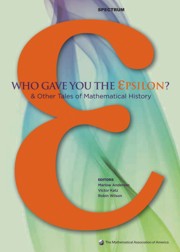Book contents
- Frontmatter
- Introduction
- Contents
- Analysis
- Geometry, Topology and Foundations
- Algebra and Number Theory
- Foreword
- Hamilton's Discovery of Quaternions
- Hamilton, Rodrigues, and the Quaternion Scandal
- Building an International Reputation: The Case of J. J. Sylvester (1814–1897)
- The Foundation Period in the History of Group Theory
- The Evolution of Group Theory: A Brief Survey
- The Search for Finite Simple Groups
- Genius and Biographers: The Fictionalization of Evariste Galois
- Hermann Grassmann and the Creation of Linear Algebra
- The Roots of Commutative Algebra in Algebraic Number Theory
- Eisenstein's Misunderstood Geometric Proof of the Quadratic Reciprocity Theorem
- Waring's Problem
- A History of the Prime Number Theorem
- A Hundred Years of Prime Numbers
- The Indian Mathematician Ramanujan
- Emmy Noether
- “ Marvelous Proof,”
- Afterword
- Surveys
- Index
- About the Editors
Hermann Grassmann and the Creation of Linear Algebra
from Algebra and Number Theory
- Frontmatter
- Introduction
- Contents
- Analysis
- Geometry, Topology and Foundations
- Algebra and Number Theory
- Foreword
- Hamilton's Discovery of Quaternions
- Hamilton, Rodrigues, and the Quaternion Scandal
- Building an International Reputation: The Case of J. J. Sylvester (1814–1897)
- The Foundation Period in the History of Group Theory
- The Evolution of Group Theory: A Brief Survey
- The Search for Finite Simple Groups
- Genius and Biographers: The Fictionalization of Evariste Galois
- Hermann Grassmann and the Creation of Linear Algebra
- The Roots of Commutative Algebra in Algebraic Number Theory
- Eisenstein's Misunderstood Geometric Proof of the Quadratic Reciprocity Theorem
- Waring's Problem
- A History of the Prime Number Theorem
- A Hundred Years of Prime Numbers
- The Indian Mathematician Ramanujan
- Emmy Noether
- “ Marvelous Proof,”
- Afterword
- Surveys
- Index
- About the Editors
Summary
There is a way to advance algebra as far beyond what Vieta and Descartes have left us as Vieta and Descartes carried it beyond the ancients … We need an analysis which is distinctly geometrical or linear, and which will express situation directly as algebra expresses magnitude directly.
Leibniz ([17], p. 382)1 Introduction
From Pythagoras to the mid-nineteenth century, the fundamental problem of geometry was to relate numbers to geometry. It played a key role in the creation of field theory (via the classic construction problems), and, quite differently, in the creation of linear algebra. To resolve the problem, it was necessary to have the modern concept of real number; this was essentially achieved by Simon Stevin, around 1600, andwas thoroughly assimilated into mathematics in the following two centuries. The integration of real numbers into geometry began with Descartes and Fermat in the 1630s, and achieved an interim success at the end of the eighteenth century with the introduction into the mathematics curriculum of the traditional course in analytic geometry. Fromthe point of view of analysis, with its focus on functions, this was entirely satisfactory; but from the point of view of geometry, it was not: the method of attaching numbers to geometric entities is too clumsy, the choice of origin and axes irrelevant and (in view of Euclid) unnecessary.
Leibniz, in 1679, had mused upon the possibility of a universal algebra, an algebra with which one would deal directly and simply with geometric entities. The possibility is already suggested by a perusal of Euclid.
- Type
- Chapter
- Information
- Who Gave You the Epsilon?And Other Tales of Mathematical History, pp. 291 - 298Publisher: Mathematical Association of AmericaPrint publication year: 2009

